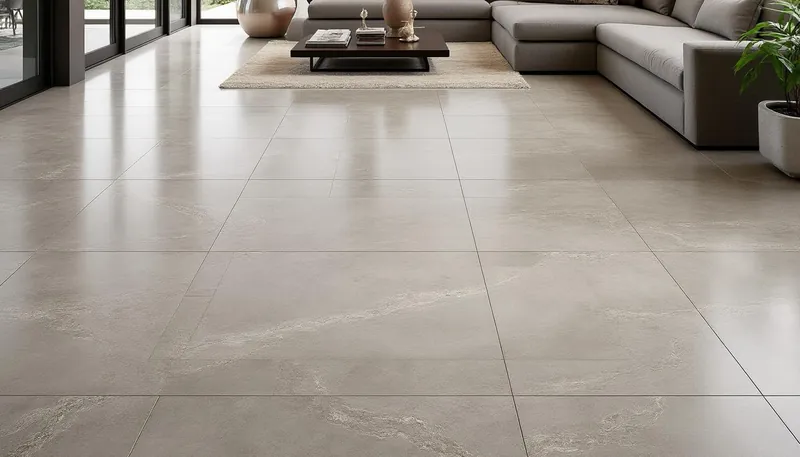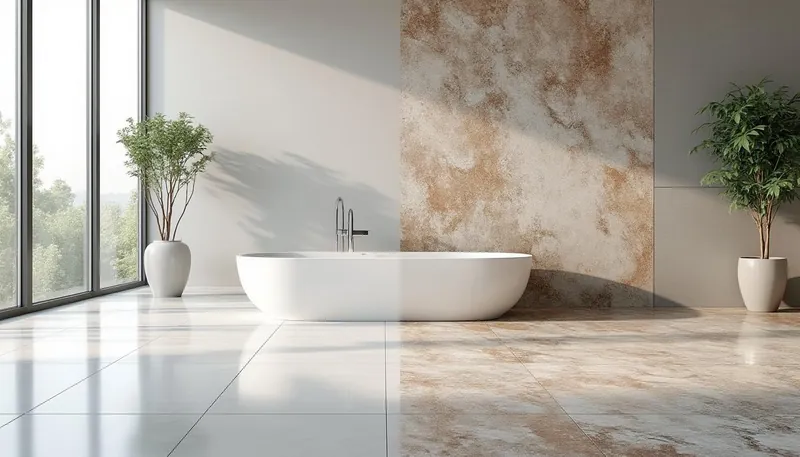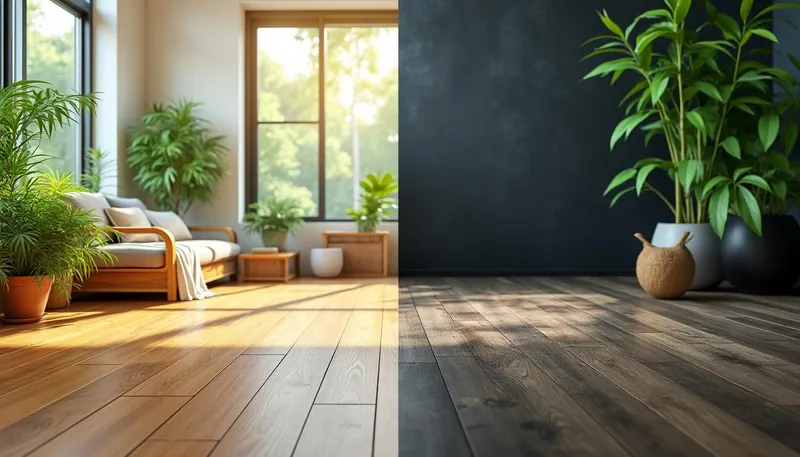The quest for the perfect flooring material often leads homeowners to weigh the benefits of tile flooring versus natural stone. Each choice presents a unique blend of aesthetic appeal, budget considerations, and maintenance requirements. Whether it’s the luxurious allure of marble or the practical resilience of porcelain, making the right selection can significantly impact your home’s ambiance and functionality. In this exploration, we’ll dissect these key flooring options to illuminate their respective strengths and weaknesses, catering to diverse lifestyles and spaces.
Brief:
- 🌟 Natural stone offers unique beauty but requires more maintenance.
- 🏗️ Tile, particularly porcelain, provides durability and low upkeep.
- 💰 Cost varies significantly between materials, with natural stone often being higher.
- 🛠️ Installation complexity differs, with natural stone needing expert handling.
- 💧 Water resistance is a major factor, especially for wet areas.
A Deep Dive into Natural Stone Flooring
Natural stone flooring is extracted directly from the earth and shaped through geological processes that span millions of years. Varieties such as granite, marble, slate, and limestone stand out not only for their inherent beauty but also for their durability. Each type carries its own set of characteristics.
Visual Appeal
One of the most significant advantages of natural stone is its visual appeal. Every piece of natural stone is distinctive due to the variations that occur naturally in its formation. Homeowners often choose stone not just for practicality but also for its organic aesthetic that enriches the interior design. The unique veining and color patterns found in stones like marble can serve as an artistic centerpiece in spaces such as living rooms or entryways.
Durability and Longevity
Durability is another hallmark of natural stone. Generally speaking, stones like granite offer robustness, making them suitable for high-traffic areas. However, varying degrees of porosity among different stones require homeowners to consider a sealing routine to prevent stains and enhance longevity. For instance, while granite is less porous and more resistant, materials like marble may need more frequent sealing due to their susceptibility to etching and staining from acids.
Maintenance Considerations
Unlike manufactured tiles, natural stone flooring necessitates a more vigilant maintenance routine. Homeowners must regularly *seal* the surface, often annually, depending on foot traffic and usage. Additionally, cleaning solutions must be selected with care—avoid acidic cleaners as these can damage softer stones like limestone and marble.
| Type of Stone | Porosity | Sealing Frequency | Acid Resistance |
|---|---|---|---|
| Granite | Low | Every 2-3 years | High |
| Marble | Medium | Annually | Low |
| Limestone | High | Annually | Low |
| Slate | Medium | Every 2 years | Medium |

Exploring Tile Flooring: A Versatile Alternative
Tile flooring, particularly ceramic and porcelain, is manufactured from a blend of clay, sand, and other raw materials that undergo a firing process at high temperatures. This results in a durable product that is less porous than most natural stones. With advances in technology, porcelain tiles can now replicate the look of popular stones like marble with remarkable accuracy, making them a favored choice for many homeowners.
Durability and Water Resistance
When it comes to durability, porcelain tile often outperforms natural stone. For example, porcelain tiles have a water absorption rate of just 0.5%, making them nearly waterproof and ideal for moisture-prone areas such as kitchens and bathrooms. In contrast, natural stone may absorb water through its pores, necessitating regular sealing. The high durability of porcelain means that it is less likely to scratch or chip under heavy traffic, offering a practical solution for busy households.
Maintenance and Care
Maintenance is another area where porcelain and ceramic tiles shine. Unlike natural stones, which require special cleaning products to avoid damage, glazed tiles can be easily cleaned with mild detergent and water. While grout lines may require occasional cleaning and sealing, the overall maintenance of tiles is significantly lower. This makes tiles a more appealing option for homeowners looking to minimize upkeep. 👌
Cost Considerations
In terms of cost, tile generally proves to be more budget-friendly compared to natural stone. While high-end porcelain tiles can be expensive, they often remain less costly than premium natural stones. This allows homeowners to strike a balance between quality and budget considerations while still achieving an appealing aesthetic.
| Type of Tile | Durability | Water Resistance | Maintenance |
|---|---|---|---|
| Ceramic Tile | Medium | Glazed: High | Low |
| Porcelain Tile | High | Very High | Very Low |
Practical Differences in Installation
Installation differences present another layer of decision-making for homeowners. Natural stone is typically heavier and requires skilled labor to install, especially due to its irregular shapes and sealing requirements. On the other hand, tiles are usually made in standard sizes, making them more straightforward to work with, easier to handle, and quicker to install. This aspect can translate into lower installation costs for homeowners opting for tile flooring versus natural stone.
Factors Influencing Installation Complexity
- 🏗️ Weight: Natural stone demands more careful handling and support.
- 🛠️ Labour Skills: Installing stone requires more specialized skills compared to tile.
- 🕒 Time Efficiency: Tiles can often be laid down in a fraction of the time it takes to install stone.
When to Choose Which Option
Deciding between tile and natural stone boils down to your individual preferences and the requirements of your space. If you place a premium on the luxurious and unique aesthetic that natural stone brings and are willing to invest the time and effort into its maintenance, stone may be your best bet. This option can be perfect for sophisticated areas where the unique character of the stone can shine.
Conversely, if functionality, durability, and low maintenance are your primary concerns, particularly in high-traffic and wet areas, tile flooring should undoubtedly be at the top of your list. Its modern aesthetic capabilities mean that achieving the look of natural stone without the extensive upkeep is entirely feasible and practical. 🌟
What is the primary difference between tile and natural stone flooring?
The main difference lies in their material origins, with natural stone being quarried directly from the earth and tile (especially porcelain) being man-made from clay and other materials.
Is natural stone easier to maintain compared to tile?
No, natural stone often requires more frequent sealing and special cleaners, whereas tile, especially porcelain, is much easier to maintain.
How do I determine the best flooring material for my space?
Consider durability, maintenance needs, aesthetics, and budget. High-traffic areas and wet spaces might favor tiles for their resilience and ease of maintenance, while aesthetics might lead you to choose stone.
Can I use natural stone in wet areas?
Yes, but it’s essential to seal it properly to prevent moisture absorption, whereas porcelain tile is ideal for wet areas due to its low porosity.
What is the average lifespan of tile vs natural stone?
Natural stone can last several decades with proper care, while tile may last 20-30 years, depending on usage and maintenance.


